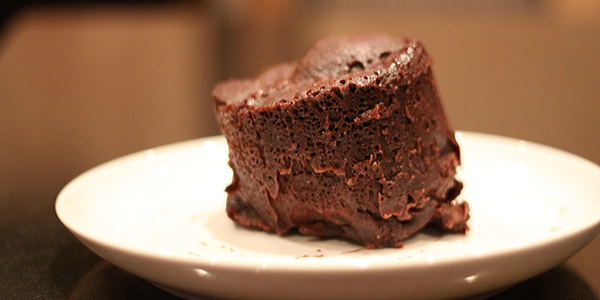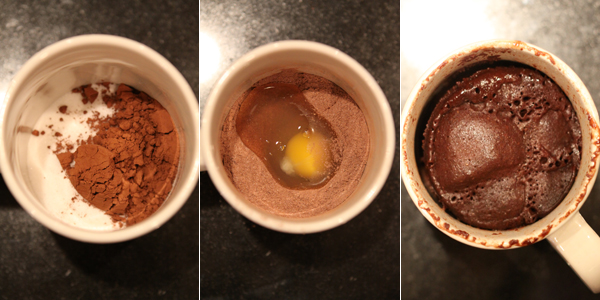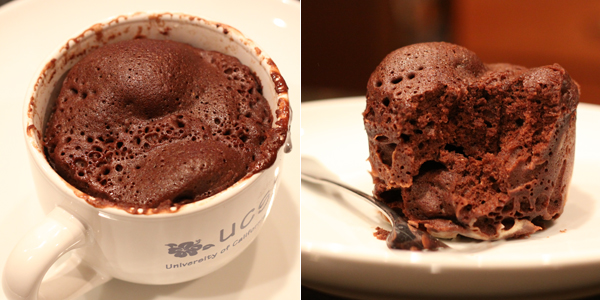
A recipe appeared in my email inbox from a friend for a “Five Minute Chocolate Cake” (recipe below). Although it caught my attention and certainly deserved a laugh, not much attention was paid to it at time. A few months later, however, and it was there in the back of my mind: Could you really bake a cake in five minutes? Digging up that email, I gave it another look.
The recipe called for the right ingredients — flour, sugar, oil, egg, cocoa, milk — but the baking method was unconventional: “microwave on high (1000 watts) for 3 minutes.” Hmmm…
Being a fan of the show MythBusters, it only seemed natural that I take their lead and proceed to dig deeper.
Myth: You can prep and bake an edible chocolate cake in the microwave, in five minutes.
Plan of attack:
1. Research cake ingredients
2. Research baking methods — conventional oven vs. microwave oven
3. Experiment in ‘baking’ the cake

Cake Ingredients:
Each ingredient in cake baking serves an important purpose, adding structure, richness, volume, color, flavor, and moisture to the resulting cake. While the five minute chocolate cake recipe contains the ingredients we would expect, one important item to note is the method in which these ingredients are incorporated into the batter.
In the one-bowl method, which this recipe calls for, the ingredients are all added together and then mixed to incorporate air and create pockets. (A more traditional method of doing this is to first cream the fat and sugar, creating tiny air bubbles that improve texture of the cake, then adding eggs followed by the liquid and flour, alternately). Given the time constraints and the size of the mixing container (mug) of the recipe, it would be expected that not a lot of air is incorporated during this process; therefore it would be expected that while the cake may rise (due to the leavening agents of the egg and the steam from cooking at a high heat), the texture will be off.
Baking Methods:
The conventional oven cooks food from the outside in, surrounding it in warm air that heats as the oven heats up. The major difference between this and microwave cooking (when it comes to baking a cake) is that the microwave oven cooks evenly and the air inside the microwave does not heat as it cooks (only the food and container get hot). The result creates major differences in our cake as we cook it in the microwave oven.
The first, that the food cooks evenly, means that we can actually cook the cake through in the small amount of time (3 minutes). If we tried to shorten the time with a conventional oven, the outside would be baked, but the inside would be a soggy mess. The second difference, that the air surrounding the food does not heat in a microwave oven, is the major difference in the crust that forms on the cake. While we don’t usually look for a crisp topping on a cake, we do usually observe a light caramelization of the sugars and a dry feel to the top as the moisture evaporates.
Experiment in “baking” the cake:
The first experiment of “baking” the cake was done exactly according to the recipe (below) received via email. There was no indication of the type of flour and it literally read to dump in, first, the dry ingredients, mix, then the eggs, mix, and then the rest of the ingredients. It did say to mix well, but it did not give an indication of time or how well. Given this, after the dry and wet were incorporated, I discontinued mixing. In addition, I used a standard (albeit quite large) mug with high sides for the container.
The result was, in fact, edible… depending on your definition of edible*. It tasted chocolatey and had a texture that resembled cake, but it was by no means delicious. Another result to note is that the cake has absolutely no shelf life. Eat it immediately or don’t eat it at all.

Taking what I had learned in the research phase I went about the recipe a third time with a different approach (pictured above). The constants were to maintain the ease of clean up (one-bowl method), the convenience of time (5 minutes), and the ingredient list. To do this, first the egg was added to the mug and whisked thoroughly with a fork. Next, the sugar was added and thoroughly whisked until light in color. The following were then added: oil, vanilla, and milk, and then last came the flour and cocoa. By doing this, I was attempting to aerate the batter with the thorough whisking of the egg and sugar before adding the other ingredients. The other change was in the mug chosen for the task — this time it was a wider, low-sided mug for baking the cake.
Although many variables were changed (making it impossible to know which caused improvement), there was an overall slight improvement to the previous version of the cake. The texture was a bit more airy and not as much moisture was left in the bottom of the mug after baking. There was no improvement to the shelf life of the cake.
*We had no problem finishing off the first version of the cake we baked, but we recognized that this was clearly because we were craving something sweet, pretty late at night. The second attempt at making the exact recipe, however, I was not as hungry and I had no issues taking two bites and dumping the rest in the trash.
Conclusion:
For a late-night chocolate fix, this will do the trick. For a regular home-baked product, however, this recipe can certainly be skipped. Given this, the conclusion is Confirmed: But Not Recommended.

Five Minute Chocolate Cake
serves 2
4 tbsp flour
4 tbsp sugar
2 tbsp cocoa
1 egg
3 tbsp milk
3 tbsp oil
3 tbsp chocolate chips (optional)
A small splash of vanilla extract
1 large coffee mug (microwave safe)
1. Add dry ingredients to mug, and mix well.
2. Add the egg and mix thoroughly.
3. Pour in the milk and oil and mix well.
4. Add the chocolate chips (if using) and vanilla extract, and mix again.
5. Put your mug in the microwave and cook for 3 minutes at 1000 watts.
6. Allow to cool a little, and tip out onto a plate if desired. EAT!

Absolutely agreed that the only purpose for this concept is after 10 p.m. Absolutely agreed must be eaten immediately, preferably with vanilla ice cream to counter the rubbery texture. Absolutely agreed that the Chef thinks I’m slummin’ it big time when I make this so do it when he’s not home from work yet.
I’ve heard of this, but I truely don’t understand it. I can make a molten chocolate cake (with the oven mind you) in less than 20 minutes. I’ll wait the extra 15 minutes any day! It’s well worth it.
In my world, the fancy Wolf takes far too long to preheat to use for a quick snack. The recipe was fun to to test/try but certainly will win no awards but for speed to the fix.
How about a toaster oven? Can you bake a cake in there? I’ve been pondering the purchase of one, as I’ve been told by people that own them they can’t be beat if you’re only cooking for 1 or 2.
Damn, it’s a small world. I received this email twice last year, and it bobbed to the surface of my memory this weekend. Mine was also a late-night try, and boy, you are spot-on about it suiting that time of night. My edit to the recipe was to add a few drops of peppermint oil, though I knew that this would be polishing a turd (to put it bluntly)
One-third of the way through it, my sweetness-warmness-chocolate-craving neurons were firing happily and I thought, “Hey, this could give those commercial, microwaveable, single-serving desserts a run for their money.” A few bites later, having slowed the pace considerably, I thought, “I am NOT finishing this, and I’m ashamed for having squandered my ingredients.” Incredibly — and this is what late-night sweet cravings will do to you — I put the remainder in the fridge, mostly as an experiment for later sampling. Twenty minutes later, I regretted dirtying a food storage container and tossed the last of the cake.
Blech. To quote Animal House, zero point zero.
I am a Certified Occupational Therapist Assistant and I have used your recipe in a group setting to work on cognitive and activity for daily living skills. My geriatric patients loved the recipe!
thanks!
You said it wasn’t specified in the email what kind of flour to use, and here you didn’t write that too. I hope you all used self rising flour, cause that’s the one that’s needed, otherwise the cake will stay small, won’t rise and will make a BIG difference to the taste and look, also of how compact it will be!